How to Prevent Dehydration in the Heat - Toolbox Talks
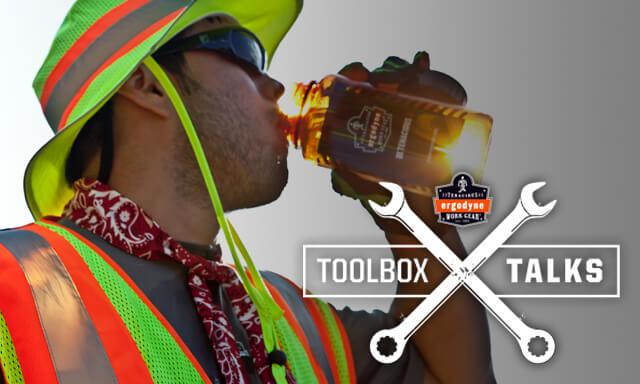
In 2014, OSHA kicked off an annual campaign to train and educate workers about heat stress management called Water. Rest. Shade. The following post will focus on water.
Download the Toolbox Talk PDF (Topic: Water) on the signs/symptoms of dehydration and effective hydration strategies to share with your crew.
Cheers. Salut. Bottoms up. However you say it, it’s time to start tippin’ ‘em back. And by that, of course, we mean water. As the summer heats up, making sure you and your workers are properly hydrated becomes more and more critical when it comes to workplace safety. While workers can still get dehydrated in the cold (check out our Toolbox Talk on smart scheduling and winter hydration), summer is when it can turn deadly serious quickly. When it comes to heat stress prevention, an ounce of prevention is better than a pound (or gallon?) of cure. So when the temperature starts to climb and the sun is blazing, it’s more important than ever to be making sure both you and your crew stay hydrated.
HOW THE BODY HANDLES HEAT
The human body maintains its internal temperature through various processes, and is efficient at maintaining a fairly constant internal temperature, even when exposed to varying environmental temperatures. This thermoregulation causes your body to shiver when it’s cold and sweat when it’s hot. And a body that is properly hydrated can thermoregulate better than a dehydrated one. To get rid of excess heat, the body dilates the arteries and veins at the skin’s surface to let heat energy radiate out of the body. Sweating starts next which further cools the body as it evaporates off the skin.
Problems arise when the body gets too hot or is in the heat too long that the body’s evaporative cooling method fails to properly cool the body. When exposed to extreme heat for too long, the body sweats so much that it depletes itself of the necessary water and salts needed to sustain the evaporation process. When this process stops altogether, the body temperature soars and heat stroke is likely. While not all dehydration cases are this serious, dehydration can quickly go from a relatively minor problem to a life-threatening one.

WHAT IS DEHYDRATION?
Dehydration happens when your body is using or losing more fluids than you’re taking in. You lose fluids through sweat and urination and if you aren’t replacing those fluids and keeping up with your body’s demand, you can start to feel the symptoms of dehydration. The average person’s body has over 2.6 million sweat glands and when the body heats up, the brain tells those glands to start producing sweat in order to cool the body. The sweat then evaporates off the body, which works to begin cooling it down. Sweat is primarily composed of water and electrolytes, which are various salts excreted by the body (sodium, calcium, potassium, chlorine, phosphate, and magnesium). These electrolytes form electrically charged particles (ions) in the body’s fluids. These ions then carry the electrical energy necessary for many functions, including muscle contractions and transmission of nerve impulses. They’re also responsible for moving nutrients in and wastes out of your cells, balancing your body’s pH level and ensuring your nerves, muscles, heart and brain are all working properly. When the electrolyte balance in your body is low due to dehydration, you may start to notice muscle cramping as one of the first signs. Muscle cramps are one of the first signs of heat-related illness and a signal that rest, shade and rehydration are needed.
Other symptoms of dehydration include:
- Extreme thirst
- Less frequent urination
- Dark-colored urine
- Fatigue
- Dizziness
- Confusion
- Muscle cramps
- Nausea, dizziness or confusion
At first, dehydration triggers the feeling of thirst as a powerful motivator to get people to drink more fluids. If the fluid intake is not sufficient enough for the body’s needs, dehydration becomes more severe, sweating decreases, urine output is decreased and water moves from inside the cells into the bloodstream in order to maintain the necessary amount of blood volume and pressure. If dehydration continues to progress, the tissues of the body literally begin to dry out and malfunction causing shock and severe damage to internal organs like kidneys, liver and brain. If left untreated, the person can slip into a coma.
WHO IS AT RISK?
Anyone who has to work in hot, humid conditions regularly are the ones primarily at risk for heat-related illnesses and dehydration. Construction, agriculture, manufacturing plants, foundries and metal-processing plants are generally areas in which workers are frequently exposed to high temperatures. Workers who are required to wear heavy protective equipment are also at risk for becoming dehydrated and overheated.
According to EHS Today, “industry estimates place the number of workers for whom heat stress is a potential safety and health hazard at 5 million to 10 million.” These are workers who need to stay on top of their hydration or run serious health risks. Workers who are properly hydrated feel more comfortable in the heat and are more alert than workers who are overheated and under-hydrated.
Workers in high altitudes or dry climates are also more susceptible to dehydration. High altitudes and dry climates are so dehydrating because there is such little moisture in the air and what little moisture is present gets quickly absorbed into the air. The air will attempt to draw moisture from anything it can, including your body. This dry air will sap moisture from wherever it can, meaning you and your crew will need to be extra diligent about ensuring proper hydration.
Humid climates can also be an issue for the opposite reason – there is so much moisture in the air that your sweat doesn’t evaporate. As your body heats up, it continues to produce more and more sweat in an attempt to cool your body, but as your body continues to heat up, the more soaked your skin and clothes become with nowhere for that moisture to go. Your body will have a harder time cooling down and you will become dehydrated faster because of the increase in sweat. The heat index chart takes the air temperature combined with the humidity to give you a “feels like” temperature to your body.
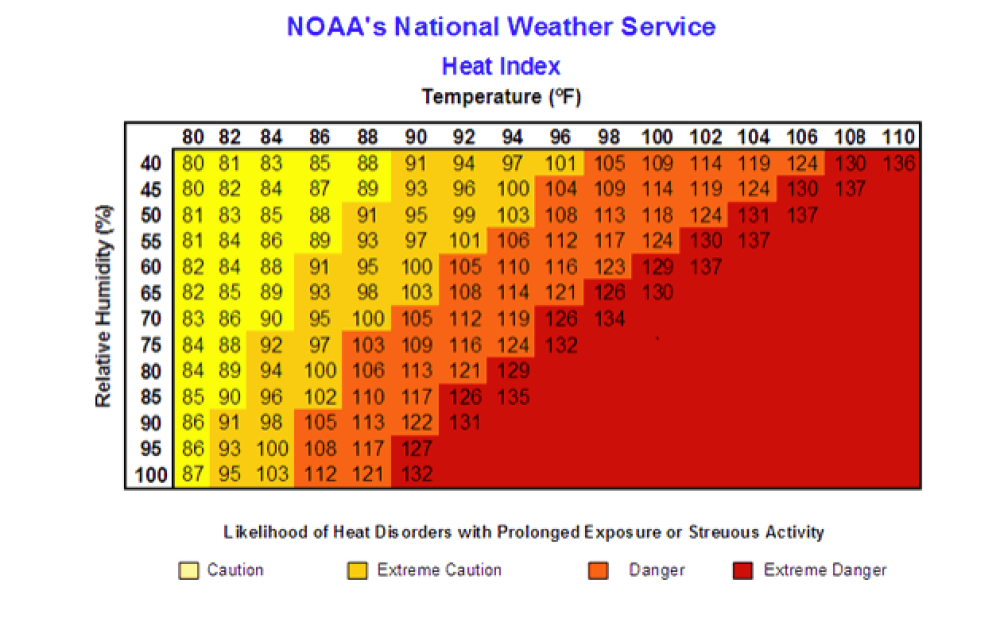
Older workers are also more susceptible to dehydration, because as we age, it’s thought that a change in hormones and dopamine levels can affect regulation of thirst, meaning older adults aren’t feeling as thirsty, and are therefore drinking less frequently than their younger counterparts even though they both require the same amount of water intake.
HOW TO HYDRATE
Did you know that when your thirst response kicks in and you actually start to feel thirsty, your body is already slightly dehydrated? And when you’re already at a deficit, it’s hard to get ahead. Which is why it’s critical, especially in hot, humid or especially dry environments, to stay on top of your hydration game throughout the day. Hydration experts from NIOSH, ACGIH, and OSHA recommend drinking 5-7 ounces of water or a sports drink every 15 - 20 minutes. It’s better to be periodically drinking water throughout the day rather than just chugging a couple of bottles during a break or at lunch. Drinking consistently throughout the day helps to better regulate your core temperature and reduces strain on your cardiovascular system by keeping steady consistent body temperature.
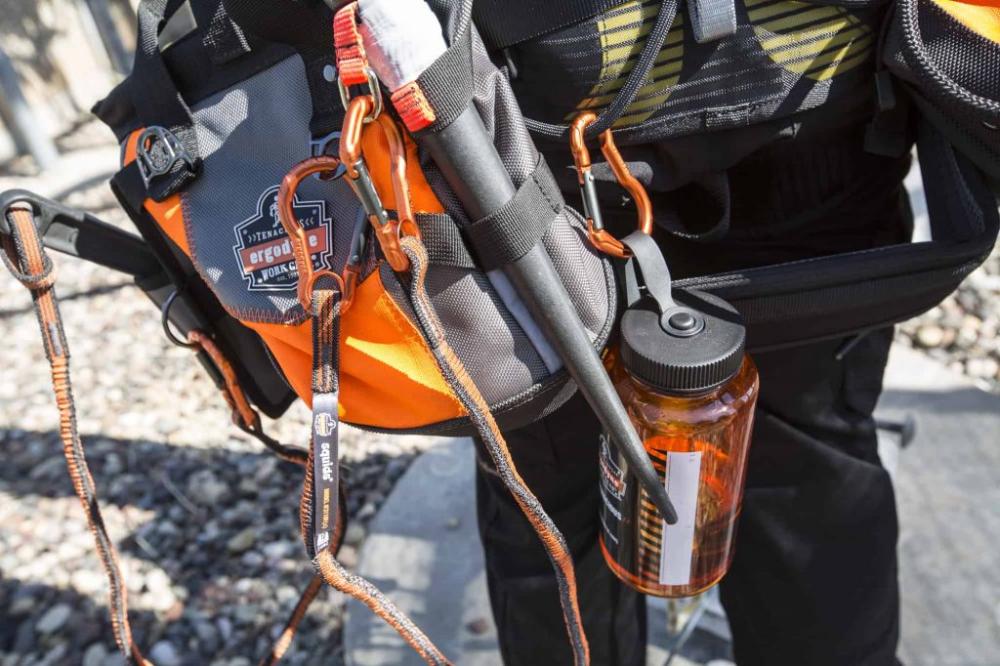
As a general guideline, the recommended amount of water intake is one quart per hour of active work or exercise for the average adult. That is the equivalent of 128 ounces (3.78 liters) every four hours at minimum. Per OSHA, it’s also suggested that the water intake be distributed over time (every 15 minutes during a shift).
Tips for staying hydrated on the job
- Drink water before, during and after your shift
- Drink 5-7 ounces of fluids every 15-20 minutes
- Keep individual containers of cool, clean water within easy reach at all times
- Drink cool water, which is absorbed more quickly by the body rather than warm or very cold water
- Try sports drinks with carbs and electrolytes to replenish those lost in sweat
- Avoid coffee, tea and soda which act as a diuretic, and obviously, never drink alcohol during work. Try to limit or eliminate alcohol even after work if possible as it further dehydrates you
HOW TO GAUGE YOUR HYDRATION
If you are following the guidelines above, and you aren’t feeling thirsty, the best way to gauge proper hydration is the color of your urine. If it’s a pale or very light yellow, you’re hydrated and should stay the course of your fluid intake. If it’s completely clear, you’re overhydrated (yep, that’s definitely a thing) and may need to scale back your intake slightly. The darker your urine, the more dehydrated you are and the more you should focus on drinking until it gets to that very pale color. Dehydration is more than just feeling thirsty, it can have serious repercussions and can affect productivity and your overall health.
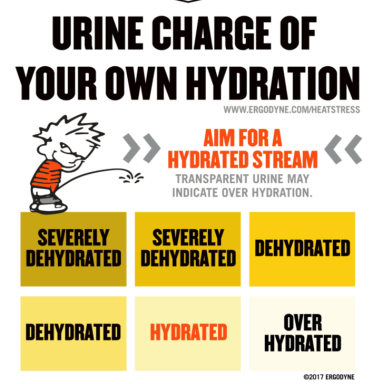
HYDRATION SOLUTIONS
Jobsites are required to have drinking water available, and some states like Washington and California have requirements on how much water should be provided per worker (enough so that each worker can drink up to 1 quart per hour on an 8-hour shift). The water must be fresh, pure, suitably cool and provided to employees free of charge. OSHA also requires that the water supply be accessible to all employees and if cups are provided, they must be single-use disposable cups. In addition to disposable cups or water bottles, workers can take their hydration into their own hands with their own water bottle.
Reusable plastic versions are common, lightweight and resist cracking. They come in all sorts of shapes, sizes and features and can be refilled all day.
Stainless steel water bottles are generally more insulated and will keep water cool throughout the day. These are a little heavier than their plastic counterparts but are much better at staying sweat-free and cooler inside.
Hydration packs are another option for all-day hydration. These backpack-style packs hold more water than a water bottle and come in a variety of sizes and options.
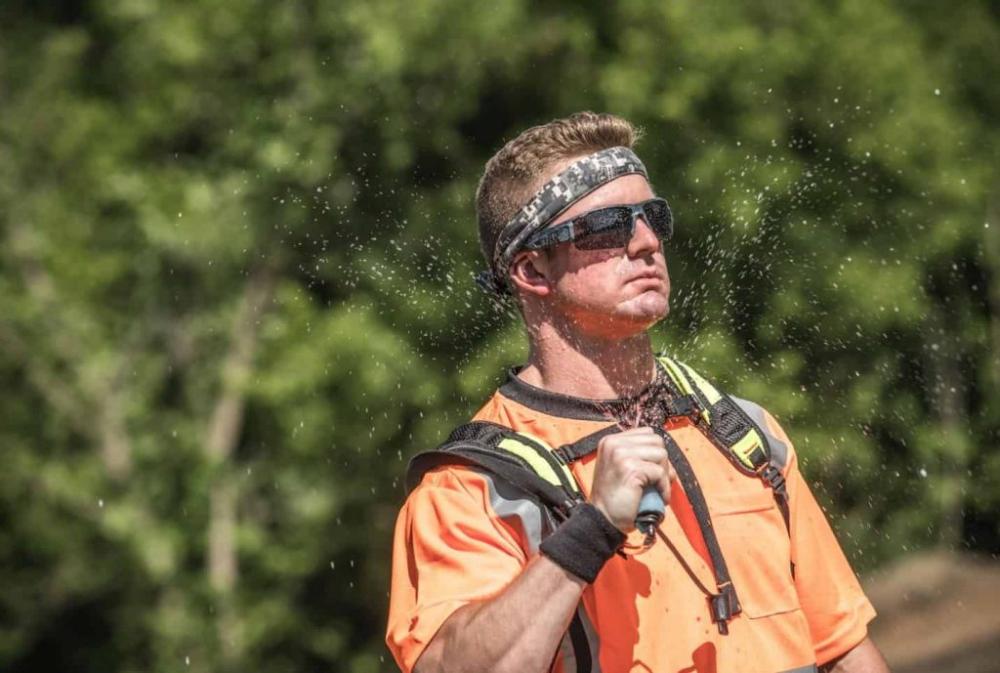
TALK TO YOUR CREW
When it comes to staying hydrated, a little prevention goes a long way. Heat stress is entirely preventable with just a little advanced planning and smart hydration solutions. Talk to your crew and encourage regular water drinking so they stay healthy in the heat.


